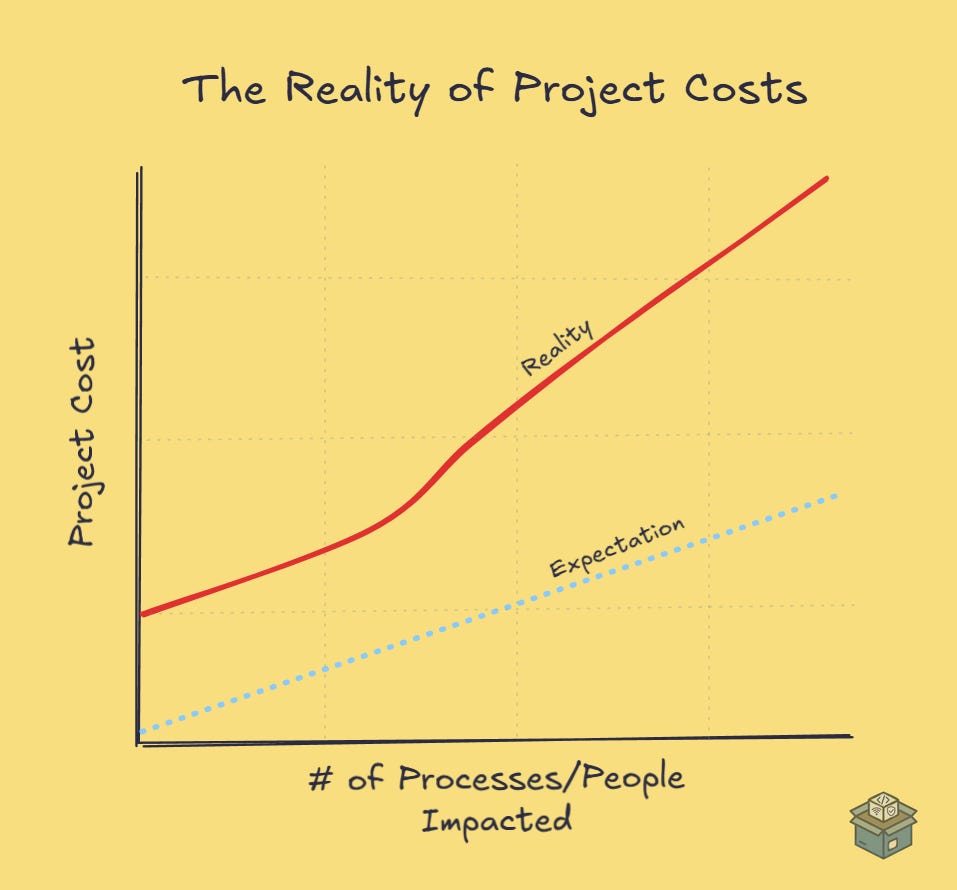Yes, Big Projects Are Expensive (And That's Reality)
Understanding why changing how people work costs more than you think.
TL;DR
Big projects are expensive. But the real problem isn’t the price tag, it’s the shock when people don’t understand why costs skyrocket. Every extra department, legacy system, and approval loop turns a simple initiative into a slow-moving, budget-burning monster. IT leaders who don’t get this will end up stuck in never-ending steering committees while the business loses patience. Stop pretending complexity is free, set realistic expectations, and run projects with clear priorities…or get ready to watch them spiral out of control. Everyone knows when they are on a death march.
I've noticed something interesting in my conversations with companies about digital transformation projects and initiatives. There's always this moment, right after I or someone walks through a detailed proposal, where a stakeholder shifts uncomfortably in their chair and says:
"This seems...expensive."
They're right. It is expensive. And you know what? It should be.
Let me explain why this isn't just okay, it's expected.
The Reality of Scale and Complexity
I've been the proud sponsor of more enterprise technology projects than I care to count: ERP conversions that made Finance lose sleep, ecommerce tech stack implementations that Marketing swore would revolutionize everything, HRIS migrations that HR both loved and feared, and infrastructure overhauls that only IT understood.
Through all of these, I've noticed a pattern that's almost mathematical in its consistency: the cost of a project directly correlates with how many business processes and employee groups get pulled into the mix.
Think about it this way:
When you're working on a small IT initiative that affects one department and maybe touches a couple of processes? The costs stay relatively manageable. It's like cooking dinner for your family. You know the recipe, you know the portions, you can handle the variables.
Note: My “Eh, we’ll figure it out, we don’t need to measure anything” cooking strategy at home does not apply here. Ask my wife and kids.
But what happens when you start involving multiple departments, interconnected processes, and layers of complexity? The costs don't just increase linearly, they explode almost logarithmically. Suddenly, you're not cooking dinner for your family; you're running a restaurant during rush hour.
Why The Math Makes Sense
Here's what most people miss when they look at project costs: complexity compounds.
When you add another department or process to the mix, you're not just adding their individual costs. You're adding:
The time it takes to get everyone aligned (and re-aligned when things change)
The effort required to document and standardize processes that "everyone just knows"
The complexity of integrating with existing systems that nobody wants to touch
The political navigation required when Department A's "must-have" feature conflicts with Department B's workflow
Plus there's always that one critical process that "Bob from Accounting set up 15 years ago" that nobody fully understands but everyone depends on. But we’re afraid of Bob as if he is an untouchable deity and work around him. More organizations have a “Bob” than not, particularly in the B2B industry. Turns out, Bob is a super chill guy and is surprised nobody has asked him how things work in 8 years.
The Hidden Multipliers
Want to know why that logarithmic curve kicks in? Here are the real cost multipliers that most project estimates don't explicitly call out:
Cross-functional Dependencies: Every time two departments need to agree on something, add time and money.
Legacy System Integration: Those old systems you can't get rid of? They need special care.
Change Management: The more people involved, the more time you spend on training, communication, and handling resistance.
Risk Mitigation: Bigger projects mean bigger potential failures. Insurance isn't cheap.
Here’s an illustrative rule of thumb that certainly does not apply to all circumstances, but you get the gist:
The Invoice Is Just The Beginning
Here's something that also gets missed in budget discussions: that big number on the vendor invoice? It's only part of the story.
When you pull your best people into a major project, the ripple effects spread across your entire organization. Your star developer shifts from maintaining critical systems to implementation work. Your brilliant business analyst stops optimizing current processes to document new ones. Department heads find themselves trapped in endless planning meetings instead of driving their teams forward. And your subject matter experts? They're so busy documenting processes that customer problems start piling up.
Remember, you don’t have an endless about of internal resources that you’re already trying to maximize.
This isn't just about tracking hours and salaries, it's about the opportunities your team isn't pursuing while they're heads-down on the project.
Internal [opportunity] costs rarely show up in project budgets. They're buried in departmental headcounts and quarterly objectives. But they're just as real as that vendor invoices…sometimes more so. It’s a silent killer and by the time you know it, it’s EOY.
So What's The Alternative?
Here's a question I ask when I sense the sticker shock setting in:
If we could magically solve this problem for half the price, but it only works 80% of the time—would we take that deal?
The answer is almost always no. Because in B2B, "mostly working" is the same as "not working at all”. Hard pill to swallow but we’ve all experienced it. We’re talking about BHAG projects here, not small pet projects.
Making Peace with Reality
Yes, we absolutely work to optimize costs. We look for efficiencies, we reuse components, we stretch our resource constraints, and we phase implementations thoughtfully. But at some point, you have to accept that making enterprise-grade sausage takes enterprise-grade effort.
The next time you're looking at a big project proposal or conjuring up your business case to present to the board and feeling that budget anxiety creep in, remember: the cost isn't just about the technology. It's about the complexity of changing how people work while keeping the business running.
Sometimes expensive is exactly what it should be.
What's your experience with large-scale projects? Have you found ways to manage the complexity curve? Let me know in the comments below.





